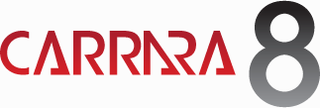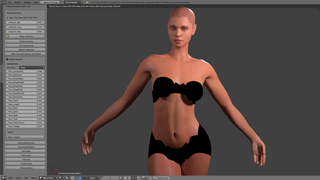Autodesk 3ds Max, formerly 3D Studio and 3D Studio Max, is a professional 3D computer graphics program for making 3D animations, models, games and images. It is developed and produced by Autodesk Media and Entertainment. It has modeling capabilities and a flexible plugin architecture and must be used on the Microsoft Windows platform. It is frequently used by video game developers, many TV commercial studios, and architectural visualization studios. It is also used for movie effects and movie pre-visualization. 3ds Max features shaders, dynamic simulation, particle systems, radiosity, normal map creation and rendering, global illumination, a customizable user interface, and its own scripting language.

Poser is a 3D computer graphics program distributed by Bondware. Poser is optimized for the 3D modeling of human figures. By enabling beginners to produce basic animations and digital images, along with the extensive availability of third-party digital 3D models, it has attained much popularity.

The Hyper Neo Geo 64 is an arcade system created by SNK, and released in September 1997, as the successor of the Neo Geo MVS, within the Neo Geo family.

Skeletal animation or rigging is a technique in computer animation in which a character is represented in two parts: a surface representation used to draw the character and a hierarchical set of interconnected parts, a virtual armature used to animate the mesh. While this technique is often used to animate humans and other organic figures, it only serves to make the animation process more intuitive, and the same technique can be used to control the deformation of any object—such as a door, a spoon, a building, or a galaxy. When the animated object is more general than, for example, a humanoid character, the set of "bones" may not be hierarchical or interconnected, but simply represent a higher-level description of the motion of the part of mesh it is influencing.

Bryce, also often referred to colloquially as Bryce3D, is a 3D modeling, rendering and animation program specializing in fractal landscapes. The name is taken from Bryce Canyon—a rugged region with many of the same landscapes that were first simulated with the software.
COLLADA is an interchange file format for interactive 3D applications. It is managed by the nonprofit technology consortium, the Khronos Group, and has been adopted by ISO as a publicly available specification, ISO/PAS 17506.

Daz Studio is a free media design software developed by Daz 3D. Daz Studio is a 3D scene creation and rendering application used to produce images as well as video. Renders can be done by leveraging either the 3Delight render engine, or the Iray render engine, both of which ship for free along with Daz Studio, or with a variety of purchasable add-on render engine plugins for Daz Studio from various vendors and companies.
Computer facial animation is primarily an area of computer graphics that encapsulates methods and techniques for generating and animating images or models of a character face. The character can be a human, a humanoid, an animal, a legendary creature or character, etc. Due to its subject and output type, it is also related to many other scientific and artistic fields from psychology to traditional animation. The importance of human faces in verbal and non-verbal communication and advances in computer graphics hardware and software have caused considerable scientific, technological, and artistic interests in computer facial animation.

Pixologic ZBrush is a digital sculpting tool that combines 3D/2.5D modeling, texturing and painting. It uses a proprietary "pixol" technology which stores lighting, color, material, orientation and depth information for the points making up all objects on the screen. The main difference between ZBrush and more traditional modeling packages is that it is more akin to traditional sculpting.

Carrara is a full-featured 3D computer graphics application featuring figure posing and editing, as well as nature modeling, in addition to traditional modeling, animation, texturing and rendering. The software is also capable of dynamic hair and fur simulations, particle effects, soft body and rigid body dynamics. Carrara is now owned and developed by Daz 3D. Carrara is compatible with Poser and Daz Studio formats of 3D figures and props. It is further supported by a number of 3rd party plug-ins and add-ons.

Digital sculpting, also known as sculpt modeling or 3D sculpting, is the use of software that offers tools to push, pull, smooth, grab, pinch or otherwise manipulate a digital object as if it were made of a real-life substance such as clay.

MakeHuman is a free and open source 3D computer graphics middleware designed for the prototyping of photorealistic humanoids. It is developed by a community of programmers, artists, and academics interested in 3D character modeling.

Daz Productions, Inc. is a 3D-content and software company specializing in providing rigged 3D human models, associated accessory content, and software to the hobbyist as well as the prosumer market.
Messiah is a 3D animation and rendering application developed by pmG Worldwide. It runs on the Win32 and Win64 platforms. It is marketed to run on Mac OS X and Linux via Wine. Messiah's fourth version, messiah:studio was released April 2009 and version 5.5b as messiah:animate was released November 2006. messiahStudio6 was released in April 2013. Messiah seems no longer maintained since 2013 (abandoned).
Shade 3D is a 3D modeling, rendering, animation, 3D printing computer program developed by e frontier Japan and published by Mirye Software. In October 2013, Shade 3D development team formed a new company called Shade3D Co.,Ltd., and continue to develop and market the program. After terminating the sales agreement with e frontier Japan and Mirye Software by the end of December 2014, Shade3D company is now developing and marketing Shade 3D products in Japan and worldwide exclusively.
iClone is a real-time 3D animation and rendering software program. Real-time playback is enabled by using a 3D videogame engine for instant on-screen rendering.

Modo is a polygon and subdivision surface modeling, sculpting, 3D painting, animation and rendering package developed by Luxology, LLC, which is now merged with and known as Foundry. The program incorporates features such as n-gons and edge weighting, and runs on Microsoft Windows, Linux and macOS platforms.

Mixamo is a 3D computer graphics technology company. Based in San Francisco, the company develops and sells web-based services for 3D character animation. Mixamo's technologies use machine learning methods to automate the steps of the character animation process, including 3D modeling to rigging and 3D animation.

MB-Lab is a free and open-source plug-in for Blender for the parametric 3D modeling of photorealistic humanoid characters.











